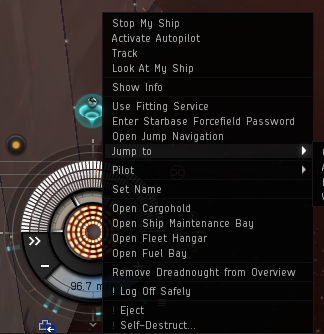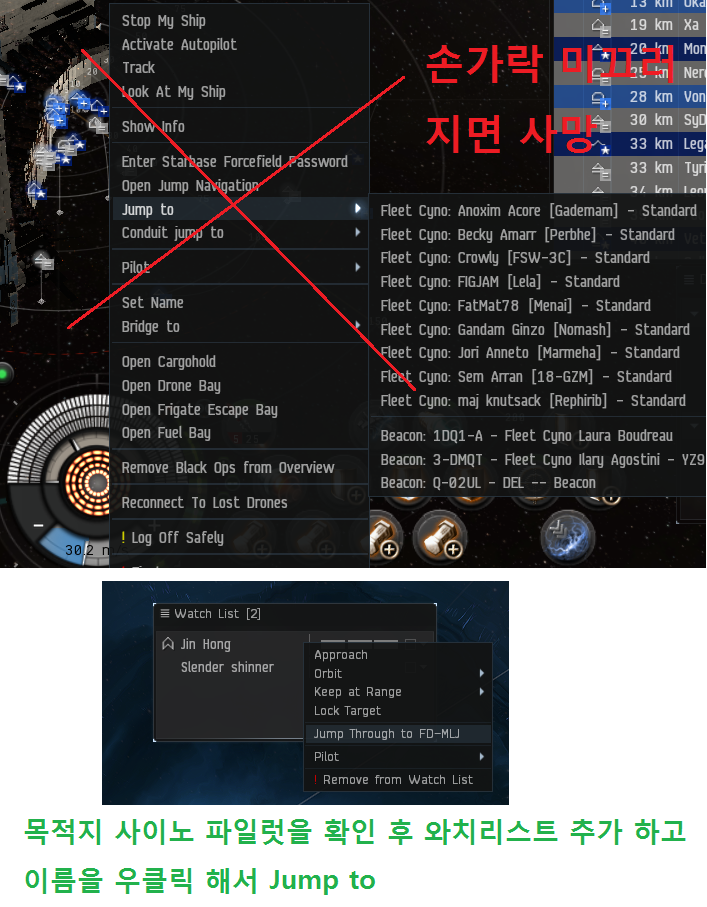User Tools
This is an old revision of the document!
Table of Contents
캐피탈쉽
이 가이드는 파일럿이 서브캡(DPS/Logi)의 플릿 운용에 대한 경험을 보유하고 있는 것으로 가정하고 오직 캐피탈의 운용의 기본에 대해서만 설명을 합니다. 이 함선을 운용하기 위해서는 독트린 최소 요구 스킬이 필요하고 Jump Drive Calibration V, Jump Fuel Conservation IV, Jump Drive Operation V etc. 여러 스킬의 선행이 요구된다.
플릿에서 운용하기 전에 캐피탈 그룹 join the capitals group 에 가입을 하여야 합니다. 캐피탈 그룹에 가입하게 되면 디스코드 챗, 포럼, 캐피탈 멈블 서브 채널과 핑 또한 캐피탈 SRP를 받을 수 있는 권한이 주어집니다.
캐피탈 플릿의 일반적 운용 흐름
General info
Fleet warps and ganks
캐피탈 쉽은 일반적으로 강력한 힘을 자랑하지만 고립된 상황일 때는 소규모 서브캐피탈 함대에게 매력적이고 갑비싼 목표가 됩니다. 사람들은 당신을 속여 함대에 함류 시키거나 함대 분대 사령관 위치에 있는 스파이를 사용하여 당신을 워프 시키고 죽이는 방식으로 당신을 위험에 빠뜨리는 것입니다. 따라서 이것을 피하려면:
- 플릿 초대를 절대 수락하지 마라.
- 언독하기 전에 플릿 조인을 수행하라.
- 혼성(섭캡&캐피탈) 플릿 또는 위험이 예상되는 플릿에서는 항상 플릿워프 제외를 눌러주도록 한다.
- 확인이 되지 않은 비콘으로 절대 점프하지 마라. 캠핑은 자주 있다.
- 플릿 내에 확인이 되지 않은 사이노로 점프하지 말아라(스파이가 있을 수 있다.)
Jump drives
당신의 캐피탈 함선은 사이노 거리내에 있는 곳으로 즉시 이동 할 수 있다.(캐피탈은 7ly(광년), 슈퍼 캐피탈은 6ly(광년)), 몇 가지 조건이 충족되어야 하는데:
- ‘점프 캡’을 유지해야여 한다.(>71.25% 캡퍼시티)
- 당신은 포인팅(워프 디스트럽터 / 스크램블) 또는 버블에 갇히지 않아야 합니다.
- 당신은 시즈 상태(자세한 내용은 후술) 또는 클락 되어 있는 상태가 아니어야 한다.
- 당신은 점프 쿨 타이머가 없어야 한다.
- 당신은 레드 점프 피로도가 없어야 한다.
- 당신은 같은 같은 플릿에 사이노를 여는 사람이 필요합니다.
- 당신의 배에는 충분한 연료(함선이 사용하는 유종 확인)가 있어야 합니다.
점프 후 시타델의 테더를 받지 못하는 시간이 약 30초이고 이것은 당신이 태클 될 수 있다는 겁니다. 이러한 상황을 피하기 위하여 빠른 도킹을 수행해야 합니다. 이것은 또한 캐피탈 급의 함선은 포르티자(슈퍼 캐피탈은 킾스타에만 도킹이 가능합니다.) 보다 작은 건물에는 도킹을 할 수 없다는 것을 알아야 합니다.
점프를 하는 동안 당신은 많은양의 캡을 사용하게 되었으므로 가능한한 빨리 캡을 채우도록 해야합니다. 이러한 것을 통하여 재 점프를 할 수 있는 준비를 하거나 위급상황시에는 이머전시 헐 에너자이저(emergency hull energizer <EHE> 독트린 피팅에 따라 바뀔 수 있습니다.)를 사용하도록 합니다.


언제든지 지켜져야 할 것으로 Pharolux Cyno Beacon(고정식 구조물로 통칭 ‘사이노 비콘’)으로 점프해서는 안됩니다. 비콘은 테더가 가능한 구조물로 부터 일정거리에 상시 고정되어 있고 해당 시설물은 취약한 시설입니다. 사이노 비콘에는 매우 빈번하게 캠핑이 많은 적들을 통하여 이루어집니다. 이러한 상황을 알지 못한 초보 캐피탈 파일럿들이 비콘으로 점프해서 격침당하기도 합니다. 심지어 어떤 경우에는 사이노 비콘을 적이 의도적으로 설치하여 함정으로 사용하며, 이러한 고정된 비콘으로 점프해 들어가 죽는 경우도 발생합니다. <패치 - 모바일 사이노 비콘이 신규 아이템으로 등장했으므로 각별한 주의 요망>
상기 그림을 염두에 두고 상기 그림의 capacitor-menu의 Jump-To sub-menu를 되도록 이면 사용하지 않도록 한다. 사이노를 열어 줄 대상자를 주시목록에 등록하도록 하고 해당 멤버를 우클릭 한 후 'Jump to Member' 메뉴를 사용하여 이동하도록 합니다.(아래 그림 참조) 이는 클릭 오류와 메뉴 아래에 보여지는 cyno-beacons 을 피하기 위한 방법이라는 것을 알아야 합니다. 그리고 다른 사람을 위해 사이노를 여는 경우 - 함대 채팅에서 ‘CCCC’ 를 타이핑하여 자신을 사이노를 열어주는 사람으로 인식하게 하는 것이 일반적인 방법입니다.

리콘쉽으로 사이노를 열수 없는 경우 모바일 사이노 비콘을 이용하여 사이노를 열수 있습니다.: https://everef.net/type/57319
Siege (Siege/Triage/Industrial Core)
Dreadnought have the Siege Module, faxes have the Triage Module (and rorquals have indy core but whatever). These use strontium clathrates to activate and immobilize your ship (preventing travel, warping, jumping, cloaking, docking etc) and prevent remote assistance (you can't be repped or receive capacitor transfer) but in exchange your local active rep gets boosted and your outgoing dps and reps get boosted. Because of these downsides FC will tell you when to siege (siege green) and when to exit siege (siege red).
It is important when you first jump in to wait until your speed is lower than 10 m/s before sieging. If you bump and siege, the increased mass from sieging will mean you maintain that speed quite well and you will drift significantly.
Fleet hangar
Your ship has a special cargo bay called a fleet hangar, this bay is private to you by default but can be opened up to fleet members or corp members by clicking the little buttons next to the hangar. This is where you can keep things like cap boosters or refits, you probably want to keep it closed to prevent thieves and only open it when needed.
Ship maintenance bay (aka SMA)
Similar to the fleet hangar the SMA can also be opened to fleet or corp members. This bay can be used to store and jump into fit ships. Possible uses cases include storing spare ships for fleet members to reship into, moving ships for move ops or carrying ammo/charges/strontium/heavywater inside industrials.
Additionally the SMA (even when closed) provides a fitting service like mobile depots to fleet members <5km away. So if you are close to another capital in fleet with you, you can refit your ship in space (see useful refits below).
Useful refits
- 500mn Microwarpdrive + 3x Inertial Stabilizers: Useful while gate travelling, one cycle of 500mn will align you to warp in 10 seconds
- Cloak: Useful for cloaking up after a small hot drop or during move ops
- Heavy cap boosters: If your fit doesn't have a cap booster you can carry extra refit cap boosters. Fit one or more so you can quickly inject capacitor
- Capacitor Flux Coils + Cap Rechargers: Similar to cap boosters, these will let you cap up passively3)
- Warp Core Stabilizers: Adds warp core strength which might help you escape being pointed
Insurance
In the event of a loss the SRP payout assumes you fully insured your capital, which can mean a ~300m loss if you do not insure. Insurance is actually quite simple, you get a base insurance payout which you get even for not insuring, and if you pay the optional premium insurance, you get back double what you paid if you die before the insurance contract (3 months) runs out. So it boils down to.. do you believe your chance of dying in the next 3 months is >50%, if so, insuring is worth it.
The reason this is complicated is because if you don't happen to die in those 3 months you have just thrown 300m away, many veterans will tell you about all the isk they've wasted insuring capitals. It's essentially a bet, and you need to make that call depending on the fight you're jumping in to, what ship you're in, how active you are planning to be (and how many capital fights you expect in the next three months) etc etc. However don't just insure a capital as soon as you buy it, wait until there's a fight and you undock.
For bomb dreads (Moros especially, Phoenixes not as much) and faxes in a big capital fight it is usually worth insuring (and FC will probably remind you). One trick to ensuring you insure, is to load up the insurance window and drag it on top of your undock button so that when FC calls for undock, you don't forget to insure.
Carriers generally don't die as often, so that call is up to you.
Hull specific summary
Dreadnoughts
The dreadnought is the damage-focussed capital class. The Bomb dread is a buffer-tanked short-range anti-capital damage dealer dropped right on top of the enemy while the Sniper dread is similar but uses long-range guns and is used at range against capitals (or perhaps battleships). The HAW dread is an anti-subcap dread with a modest active rep tank.
Often dreads do not get into the fight which is why it's suggested to use dreads on alts, while you have a character flying subcap in the main fleet.
Faxes
Faxes (Force Auxiliary) provide capital reps to both capital and subcapital friendlies alike. Fleet fax (buffer fit) are used when the enemy are expected to bring capitals while master fax are used when the enemy is expected to bring subcaps or only a few dreads. Typically the master fax are used if they can tank what the enemy is likely to bring, typically subcap vs subcap fights, while fleet faxes jump in to rep against capitals.
Carriers
Carriers provide fighter support, which are basically suped up, very long range drones. They have their own control system so you should familiarize yourself with them, that is not covered in this guide (yet).
